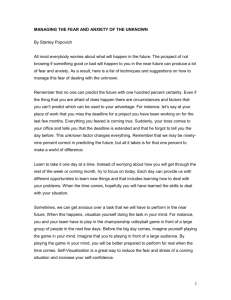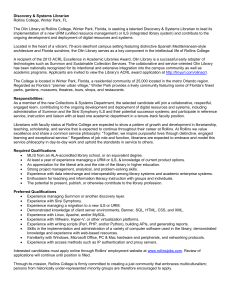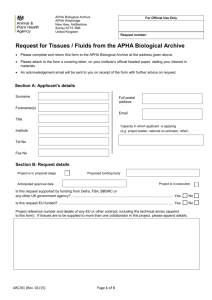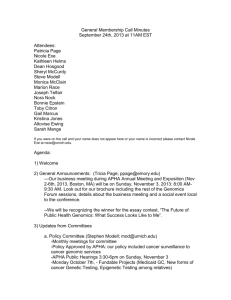Symptom / Chief Complaint
advertisement
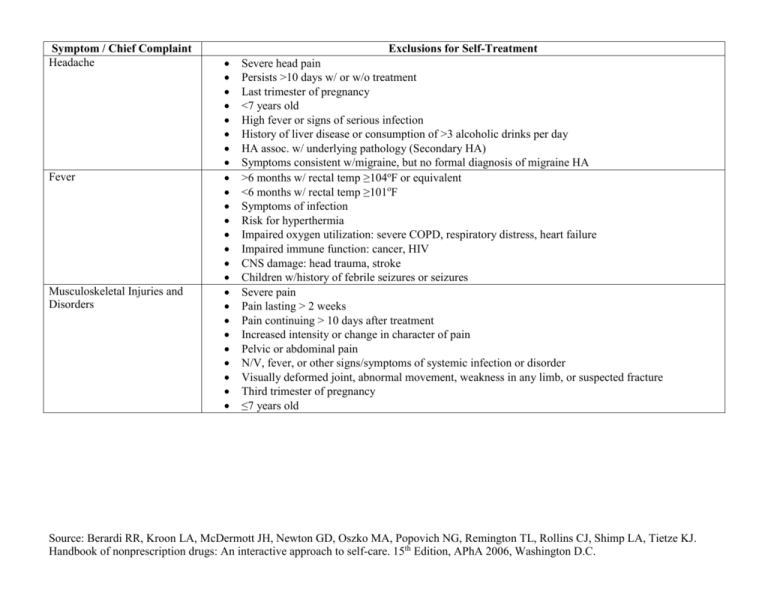
Symptom / Chief Complaint Headache Fever Musculoskeletal Injuries and Disorders Exclusions for Self-Treatment Severe head pain Persists >10 days w/ or w/o treatment Last trimester of pregnancy <7 years old High fever or signs of serious infection History of liver disease or consumption of >3 alcoholic drinks per day HA assoc. w/ underlying pathology (Secondary HA) Symptoms consistent w/migraine, but no formal diagnosis of migraine HA >6 months w/ rectal temp ≥104oF or equivalent <6 months w/ rectal temp ≥101oF Symptoms of infection Risk for hyperthermia Impaired oxygen utilization: severe COPD, respiratory distress, heart failure Impaired immune function: cancer, HIV CNS damage: head trauma, stroke Children w/history of febrile seizures or seizures Severe pain Pain lasting > 2 weeks Pain continuing > 10 days after treatment Increased intensity or change in character of pain Pelvic or abdominal pain N/V, fever, or other signs/symptoms of systemic infection or disorder Visually deformed joint, abnormal movement, weakness in any limb, or suspected fracture Third trimester of pregnancy ≤7 years old Source: Berardi RR, Kroon LA, McDermott JH, Newton GD, Oszko MA, Popovich NG, Remington TL, Rollins CJ, Shimp LA, Tietze KJ. Handbook of nonprescription drugs: An interactive approach to self-care. 15th Edition, APhA 2006, Washington D.C. Symptom / Chief Complaint Vaginal and Vulvovaginal Disorders Disorders Related to Menstruation Colds Allergic Rhinitis Exclusions for Self-Treatment Pregnancy < 12 years old Fever or pain in the lower abdomen, back or shoulder Predisposing medications to VVC: corticosteroids, antineoplastics Predisposing medical conditions to VVC: DM, HIV infection Recurrent VVC: >3 vaginal infections in a year or vaginal infection in past 2 months Severe vaginal dryness or dysparenuia Unlocalized symptoms Vaginal dryness or dysparenuia not relieved by personal lubricants Severe dysmenorrheal and/or menorrhagia Dysmenorrhea symptoms inconsistent w/ primary dysmenorrheal History of PID, infertility, irregular menstrual cycles, endometriosis, ovarian cysts Use of IUD Allergy to aspirin or NSAIDs, intolerance to NSAIDs Warfarin, heparin or lithium use Active GI disease: PUD, GERD, ulcerative colitis Bleeding disorder Severe PMS or PMDD Uncertain pattern of symptoms, particularly for emotional/psychologic symptoms Onset of symptoms coincident with use of OCs or HRT Fever >101.5oF Chest pain or SOB Worsening symptoms or development of additional symptoms during self-treatment Concurrent underlying chronic cardiopulmonary diseases: asthma, COPD, CHF AIDS or chronic immunosuppressant therapy Frail patients of advanced age Infants <9 months of age Hypersensitivity to recommended OTC medications Symptoms of otitis media or sinusitis Symptoms suggestive of lower respiratory tract problem: pneumonia, bronchitis, asthma History of non-allergic rhinitis Source: Berardi RR, Kroon LA, McDermott JH, Newton GD, Oszko MA, Popovich NG, Remington TL, Rollins CJ, Shimp LA, Tietze KJ. Handbook of nonprescription drugs: An interactive approach to self-care. 15th Edition, APhA 2006, Washington D.C. Symptom / Chief Complaint Cough Heartburn and Dyspepsia Intestinal Gas Exclusions for Self-Treatment Thick yellow sputum or green phlegm Fever > 101.5oF Unintended weight loss Drenching nighttime sweats Hemoptysis History or symptoms of chronic underlying disease associated w/cough: asthma, COPD, chronic bronchitis, CHF Foreign object aspiration Suspected drug-related cough Cough > 7 days Worsening cough or development of new symptoms during self-treatment Frequent heartburn >3 months Heartburn while taking recommended dosages of H2 blockers or PPIs Heartburn that continues after 2 weeks treatment w/ an H2 blocker or PPI Severe heartburn and dyspepsia Nocturnal heartburn Difficulty or pain on swallowing solid foods Vomiting up blood or black material or black tarry stools Chronic hoarseness, wheezing, coughing, or choking Unexplained weight loss Continuous N/V/D Pregnancy or nursing mothers Children < 12years old (antacids, H2 blockers) or <18 years old (PPIs) Persists for several months or occurs several times a month Severe debilitating symptoms Sudden change in the location of abdominal pain, significant increase in the frequency or severity of symptoms, or an onset of symptoms in individuals >40 years old Significant abdominal discomfort or sudden change in bowel function Severe or persistent diarrhea or constipation, GI bleeding, fatigue, unintentional weight loss, or frequent nocturnal symptoms Source: Berardi RR, Kroon LA, McDermott JH, Newton GD, Oszko MA, Popovich NG, Remington TL, Rollins CJ, Shimp LA, Tietze KJ. Handbook of nonprescription drugs: An interactive approach to self-care. 15th Edition, APhA 2006, Washington D.C. Symptom / Chief Complaint Constipation Diarrhea Anorectal Disorders Exclusions for Self-Treatment Marked abdominal pain or significant distention or cramping Marked or unexplained flatulence Fever Nausea and/or vomiting Paraplegia or quadriplegia Daily laxative use Unexplained changes in bowel habits, especially if accompanied with extreme weight loss Blood in stool, or dark tarry stools Change in the caliber of stool Symptoms >2 weeks or recur over a period of at least 3 months Symptoms that recur after dietary or lifestyle changes or laxative use History of IBD <6 months of age Severe dehydration ≥6 months of age with persistent high fever Blood, mucus, or pus in stool Protracted vomiting Severe abdominal pain/distress Risk for significant complications: DM, severe CVD, renal disease, multiple chronic conditions, immunocompromised patients Pregnancy Chronic or persistent diarrhea Inability of caregiver to administer oral rehydration therapy (ORT) Suboptimal response to ORT already administered < 12 years old GI diseases associated with colorectal bleeding: ulcerative colitis, Crohn’s disease Family history of colon cancer History of anorectal disorders such as abscess, fistula or fissures, neoplasm or malignancy, polyps Anorectal signs or symptoms such as severe pain, bleeding, seepage, prolapse, thrombosis, black tarry stools, moderate to severe itching, burning, inflammation, swelling, and discomfort Minor symptoms that do not respond to 7 days self-treatment Source: Berardi RR, Kroon LA, McDermott JH, Newton GD, Oszko MA, Popovich NG, Remington TL, Rollins CJ, Shimp LA, Tietze KJ. Handbook of nonprescription drugs: An interactive approach to self-care. 15th Edition, APhA 2006, Washington D.C. Symptom / Chief Complaint Nausea and Vomiting Overweight and Obesity Ophthalmic Disorders Exclusions for Self-Treatment Urine ketones and/or high BG with signs of dehydration in DM patients Suspected food poisoning that is severe and/or does not resolve after 12 hours Severe abdominal pain in the middle or right lower quadrant N/V with fever and/or diarrhea Severe right upper quadrant pain, especially after eating fatty foods Blood in vomit Yellow skin or eye discoloration and dark urine Stiff neck with or without HA and sensitivity to brightness of normal light Head injury w/ N/V, blurry vision, or numbness and tingling Persons with glaucoma, BPH, chronic bronchitis, emphysema, or asthma Pregnancy or breastfeeding Caused by cancer chemotherapy, radiation therapy, serious metabolic, CNS, GI or endocrine disorders Drug induced N/V Psychogenic induced: bulimia, anorexia Chronic disease induced: gastroparesis with DM, diabetic ketoacidosis, hyperosmolar hyperglycemic syndrome with DM, GERD Signs of severe dehydration Severe obesity: BMI ≥40 Pregnancy or breast-feeding < 18 years old or > 65 years old CV disease, dyslipidemia, DM or HTN Eating disorders Eye pain Blurred vision not associated with ophthalmic ointments Sensitivity to light History of contact lens wear Blunt trauma to eye Chemical exposure to eye Eye exposure to heat, excluding sun exposure Symptoms persisting > 72 hours Signs/Symptoms of infection of eyelids: red, thickened eyelids, scaling Source: Berardi RR, Kroon LA, McDermott JH, Newton GD, Oszko MA, Popovich NG, Remington TL, Rollins CJ, Shimp LA, Tietze KJ. Handbook of nonprescription drugs: An interactive approach to self-care. 15th Edition, APhA 2006, Washington D.C. Symptom / Chief Complaint Otic Disorders Dermatologic Disorders Contact Dermatitis Insect Bites and Stings Minor Burns and Sunburn Exclusions for Self-Treatment Signs of infection Pain assoc. with ear discharge Bleeding or signs of trauma Ruptured tympanic membrane Ear surgery w/in 6 weeks Tympanostomy tubes present <12 years old Severe condition with intense pruritis Involvement of large area of body <2 years of age Skin appears to be infected < 2 years of age Dermatitis present > 2 weeks > 25% of body surface area Numerous bullae Extreme itching, irritation, or severe vesicle and bullae formation Swelling of body or extremities, swollen eyes or eyelids swollen shut Discomfort in genitalia Involvement and/or itching of mucous membranes Impairment of daily activities Hives, excessive swelling, dizziness, weakness, N/V, difficulty breathing Allergic response away from site of sting Previous sting by honeybee, wasp, or hornet Previous severe reaction to insect bites Personal or family history of significant allergic reactions <2 years of age 2% or more body surface area involvement Involve eyes, ears, face, hands, feet or perineum Chemical burns Electrical or inhalation burns Advanced age DM or multiple medical disorders Immunocompromised patients Source: Berardi RR, Kroon LA, McDermott JH, Newton GD, Oszko MA, Popovich NG, Remington TL, Rollins CJ, Shimp LA, Tietze KJ. Handbook of nonprescription drugs: An interactive approach to self-care. 15th Edition, APhA 2006, Washington D.C. Symptom / Chief Complaint Minor wounds Fungal Skin Infections Insomnia Exclusions for Self-Treatment Contains foreign matter after irrigation Chronic wound Secondary to an animal or human bite Signs of infection Involves face, mucous membranes, or genitalia Deep, acute wound Causative factor unclear Unsuccessful initial treatment, or worsening of condition Nails or scalp involved Face, mucous membranes or genitalia involved Signs of secondary bacterial infection Excessive and continuous exudation Condition extensive, seriously inflamed, or debilitating DM, systemic infection, asthma, immune deficiency Fever, malaise or both Frequent nocturnal awakenings or early morning awakenings Chronic insomnia: >3 weeks Sleep disturbance occurring nightly for several days Sleep disturbance secondary to psychiatric or general medical disorders Source: Berardi RR, Kroon LA, McDermott JH, Newton GD, Oszko MA, Popovich NG, Remington TL, Rollins CJ, Shimp LA, Tietze KJ. Handbook of nonprescription drugs: An interactive approach to self-care. 15th Edition, APhA 2006, Washington D.C.
